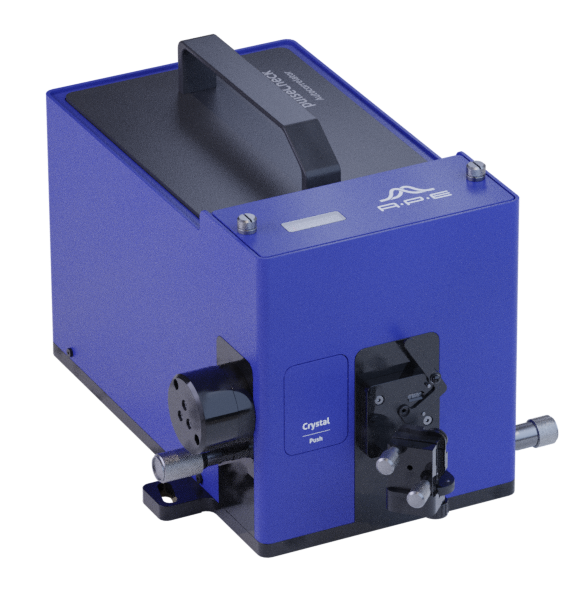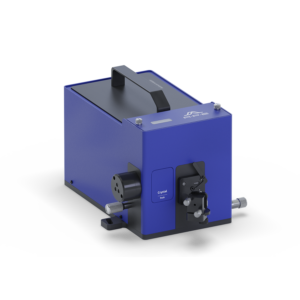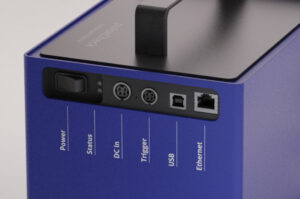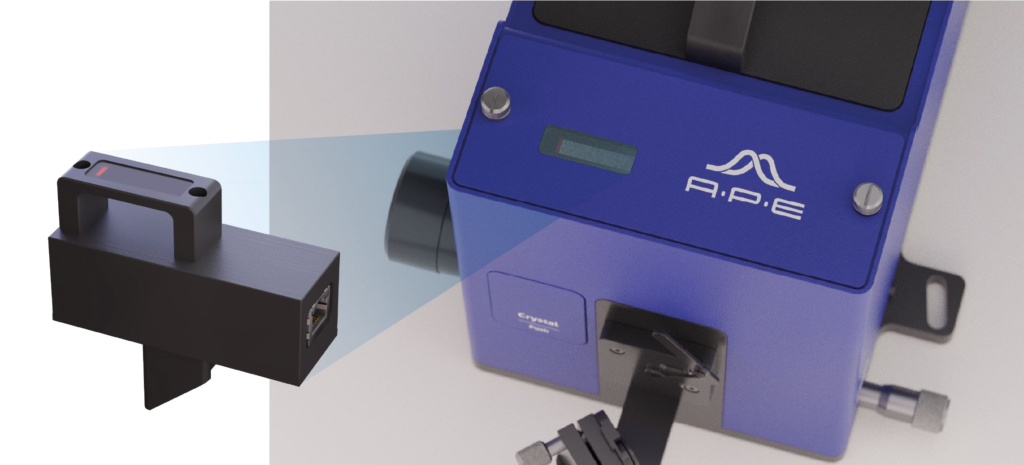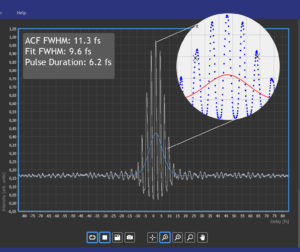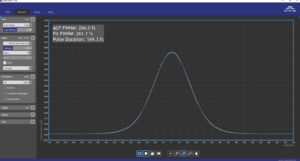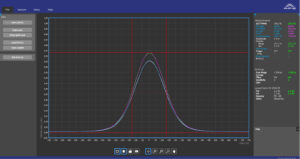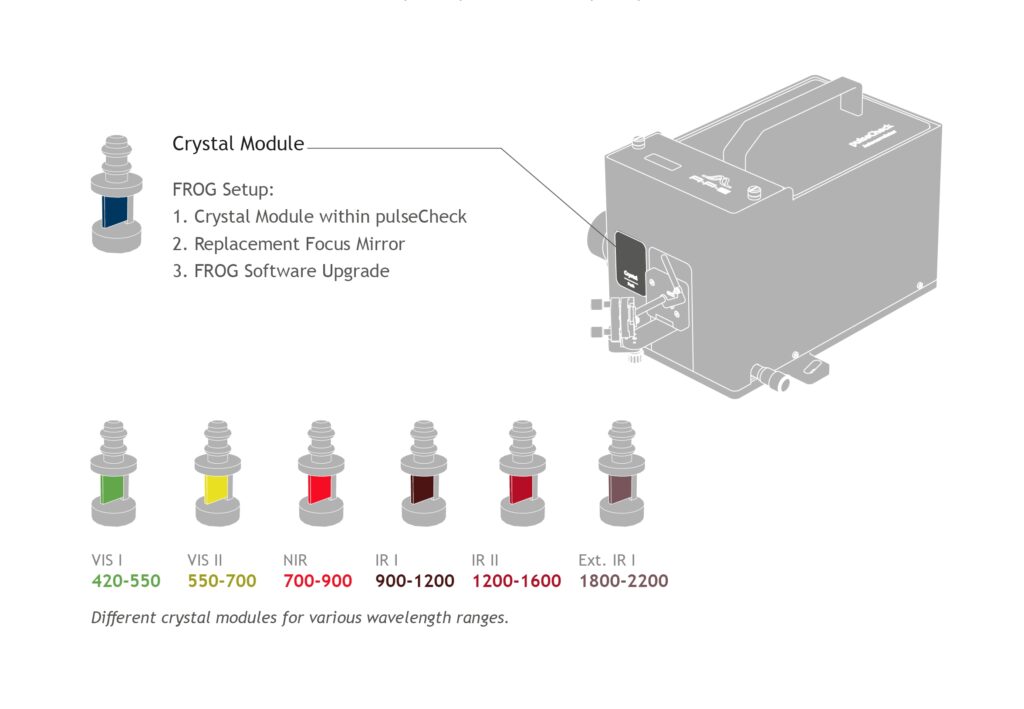pulseCheck Autocorrelators Cover the Broadest Range of Wavelengths and Pulse Widths
Optics and Detector Technology for UV to IR (200 nm … 12 µm)
A wide variety of professional applications can be covered with various detector types and optics sets. Photomultiplier (PMT) detectors are highly sensitive and are ideal for pulse measurements at low pulse energies. Photodiode (PD) detectors, on the other hand, are perfect for measuring lasers with high peak power. In combination with highly efficient optics, our detectors pave the way for measurements over a wide wavelength spectrum from 200 nm to 12 μm.
From Ultrashort to Longer Pulses
(5 fs … 500 ps)
Various pulseCheck configurations can be adapted to the individual needs of pulse duration measurement. The measurement of extra long pulse durations up to 500 ps is possible with pulseCheck SM.
NIST Traceable Calibration
An important requirement for quality assurance systems is the traceability of a measuring instrument to international or national standards. For this reason, all APE autocorrelator models are calibrated to a traceable standard according to NIST specifications (NIST = U.S. National Institute of Standards and Technology).
Each pulseCheck comes with a printed and signed calibration certificate. The calibration can of course be renewed at our premises or by a certified partner at any time.
Plug & Play and Easy Integration with Network Interface
The pulseCheck offers an intuitive plug and play capability via USB. In addition, the pulseCheck NX can be easily integrated into automated test and measurement environments using an Ethernet connection (SCPI over TCP/IP) without the necessity for an additional PC. Furthermore, the pulseCheck NX can also be controlled directly from any location over a network connection.
High Resolution &
Strong Processing Performance
The advanced system-on-chip based architecture enables measurements with low latency, a high time resolution down to 50 attoseconds and an intensity dynamic range of 18 bit. This allows full access to even the tiniest autocorrelation features.
Intuitive user interface
The pulseCheck NX software has a user-friendly interface with an intuitive layout. It allows the user to focus on relevant data and gives easy access to built-in data analysis. The high-contrast mode option of the graphical user interface (GUI) enables great visibility when using laser safety glasses.
Integrated, comprehensive data analysis
The NX software comes with comprehensive data analysis tools. Integrated functions such as the tracking of measurement and quality parameters save time. Integrated fitting algorithms make it easier to evaluate the data. Operational settings and previously acquired data can be displayed simultaneously to provide context and reference for current measurements.
Specifications
At a Glance
| pulseCheck | NX 50 | NX 150 | SM 2000 |
|---|---|---|---|
| * Measured sensitivity including optics set, defined as average power times peak power of the incident pulses PAV * Ppeak. | |||
| Pulse width | 5 fs … 15 ps | 10 fs … 40 ps | 20 fs … 500 ps |
| Wavelength range | 200 nm … 12 µm depending on optics set |
||
| Recommended repetition rate | PD, TPA: >10 Hz PMT: >250 kHz |
||
| Sensitivity*, typical | 1 W2 … 10-6 W2 depending on optics set |
||
| Max. input power, pulse energy | 0.5 W for quasi-cw laser 5 µJ for kHz laser |
||
| Input beam polarization | Linear horizontal polarization rotator optional |
||
| Input beam coupling | Free-space with 6 mm aperture fiber coupling (FC/PC or FC/APC) optional |
||
| Input beam height | 76 mm | ||
| Measurement refresh rate | 10 Hz | 7.5 Hz | 120 ps/sec |
| Delay resolution | 50 attoseconds | 200 attoseconds | 1 femtoscond |
| Contrast | 10-4 | ||
| Type of measurment mode | PMT, PD: non-collinear intensity and collinear interferometric - switchable TPA: hybrid collinear intensity |
||
| Available detector types | Exchangeable: Photomultiplier (PMT), Photodiode (PD) and Two-Photon Absorption (TPA) |
||
| Calibration | NIST traceable calibration certificate included | ||
| Electronics | Completely integrated and self-sustained | ||
| Trigger mode | TTL <50 kHz | TTL <10 kHz |
|
| Phase matching | Automatic | Software-supported | |
| Intensity resolution | 18 bit | ||
| Connectivity | Ethernet, USB, TCP/IP (SCPI command set) | ||
| Remote control | Programmable via API | ||
- Exchangeable Optics Sets for wavelength coverage from 200 nm to 12 μm
- Wide range of sensitivity levels covered with PMT, PD, and TPA
- High temporal resolution with a sampling resolution down to 50 attoseconds
- Toggle between interferometric and intensity autocorrelation
- Integrated Controller for data acquisition, data fitting, and fast FPGA data processing
- Software aided wavelength tuning of crystal (phase matching)
- Fully compliant with DIN 58175-2:2021-04 (pulse measurement)
- NX-Software and USB as well as Ethernet connection
- TCP/IP remote control with standardized command set for easy programming
- Option: FROG for complete pulse characterization
Quick Installation Guide
Datasheets & Brochures
APE pulseCheck NX+SM Rev. 4.3.1 (pdf / english)
APE FROG Rev. 4.2.1 (pdf / english)
Step Files (.stp)
APE-pulseCheck-NX-step-files-20210421 (.stp 3D CAD model with overall dimensions)
TCP/IP Sample Code for Remote Control
or
Email & Phone Contacts
APE has distributors around the world to give you the best support. Choose a country to find your local sales contact:
Optics Sets
A variety of different and exchangeable optics sets cover a wide wavelength range: from UV at 200 nm to mid IR at 12 μm.
Option FROG measurement for pulseCheck NX
Second Harmonic Generation FROG is the most popular spectrometer-less Frequency Resolved Optical Gating method. The pulseCheck NX autocorrelators by APE optionally integrate FROG, giving access to complete pulse characterization. This option allows for the comprehensive characterization of both spectral and temporal aspects of the pulses.
Visual Summary of all new pulseCheck NX Features
First-time setup of your
pulseCheck NX
Further Features
Collinear and Non-Collinear Measurements
Our autocorrelators support fast switching between collinear and non-collinear measurement modes. The collinear mode – often referred to as interferometric or fringe-resolved mode – provides additional qualitative information about the chirp and the central wavelength of the pulse. In contrast, the non-collinear mode – also referred to as intensity autocorrelation – provides background-free, high dynamic range autocorrelation. Although not background-free, switching between these two modes is even realized with the Mini TPA and TPA optics sets for pulseCheck.
Automatic Phase Matching
Autocorrelators take advantage of phase-sensitive and nonlinear processes and require what is called phase matching. APE’s pulseCheck achieves this software aided for each wavelength range, resulting in precise and fast operation without the need for manual adjustment. Measurements are made even easier by using our TPA detectors, which combine detector and nonlinear optics in a single element. Here, phase matching adjustment is no longer necessary at all.
Acquisition Software and TCP/IP Standard Software Interface
All models come with an easy to use data acquisition software, allowing for real-time data display. Furthermore, the TCP/IP-based standard software interface by APE makes it straight forward to set up remote control. This allows you, for example, to design your own automated measurement routines. Simply use our protocol templates for rapid configuration with familiar programming languages, including C++, C#, LabVIEW, Python, Matlab, and Ruby.

